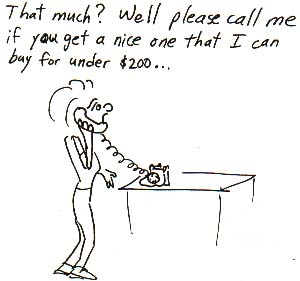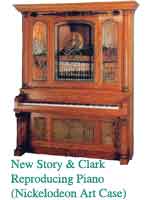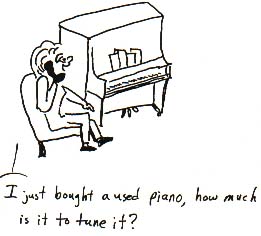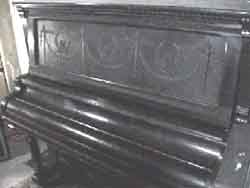|
|
 Pianos for Sale |
| The Author INTRODUCTION PIANO STYLE AND CABINET DESIGN PIANO ACTION AND TONE PRODUCTION STRUCTURE OF THE PIANO SELECTING AN OLDER PIANO |
Text by Roy E. Howard ©2002 Cantos Para
Todos Manufacturers recommended care instructions Piano Cleaning products: http://professionalpianoproducts.com/ |
|
Buying a piano is as complex as buying a car. There is a make and model and color and style and touch and tone and price to fit every taste and every pocketbook. However, it is probably a far better investment to buy a piano than a car. For a fourth to a half of the price of a car, you can get a highly technical machine with a 300 year history of reseasrch and development behind it that will likely serve you and your grandchildren, and maybe their grandchildren. A new style of music may come, but the piano will not go away. Your car will depreciate in appearance, price, style, and operating ability, but a well cared for piano will not. With almost one million new pianos manufactured each year in the world, you are not alone as a piano buyer. Many thousands of different brands still are on the market, either new or used. In the United States, it is estimated that 36% of the adult popoulation play the piano. There have been many books and articles written on the art of buying new or used pianos. If you want to read more deeply before buying a piano, one of the most authoritative books on this art is by Larry Fine (1988). The following four topics are briefly covered to help in the selection of a piano: style and cabinet design, action and tone production, structure, and selecting an older piano. The first three explain the main parts of a piano to be considered in selecting an instrument, new or used. |
|
THE ACTION At the end of the key is a screw, wire, or sticker that is
attached to or touches the "whippen". The whippen rocks when
activated by a motion of the key. Attached to the whippen are a
variety of mechanical parts that affect the motion of the
dampers and the hammers. As the key moves the whippen, the
whippen moves the damper off the string and the key toward the
string. Before the hammer hits the string. Before the hammer
hits the sttring, it is released form the jack which is tripped
by the let off button. It flies towards the string with a
velocity adjusted by the energy you apply to the key. After
hitting the string, it falls backward and is caught by the
backcheck, ready to play again. The damper stays off of the
string until you let the key rise. If a key is stuck, or a note
wont' play, or if the hammer hits the string several times, or
if the string keeps ringing after you release the key, or if the
tone of one note is different from the others, there is a
problem with the adjustment of one of the many moving parts of
the action. In comparing the actions in different pianos, you may want to consider the weight and quality of the hammers for appropriateness compared to the length of the strings. Longer strings need a heavier weight or density of wool in the hammers. More expensive pianos will have been voiced more carefully in the factory through a series of steps that bring the moving parts of the action into fine regulation and adjust the density and hardness of the hammers to a very precise standard judged by the tone of the strings when played. The action is one place where pianos differ, resulting in a special touch and tone for each brand and model. Here also is where individual differences appear from one piano to another of the same model. There is much individual hand work in the adjustment of keys, hammer felt, dampers, and all the action parts. Even every concert grand, on after another from the same assembly line will have a distinct tone and touch. In selecting your piano, study the claims of each manufacturer for differences, but ultimately select a piano that plays and sounds to your own standard. Every piano is unique. Select one that meets your needs for playing characteristics such as touch and tone. |
|
THE STRINGS When the compressed wool of the hammer strikes the taught steel
of the strings, the strings begin to vibrate. For example, the A
above middle C vibrates at 440 cycles per second. The vibration
is picked up by the hardwood bridge and passed on the the broad,
thin soundboard for amplification. All stringed instruments
operate on this same principle. Modern instruments such as the
electric guitar lack a wooden soundboard, so must be amplified
electronically. The design and quality of the strings, bridges,
and soundboard are critical to the tone of the piano. Each string vibrates in a complex pattern that includes a series of harmonic partials. The shorter the string, the stiffer it is, and the less in tune are the partials. Compare the tinny, harsh tone of the bass section of a spinet piano with the full, clear, powerful tone of a larger grand piano. You are demonstrating a principle of the physics of sound. Short strings cannot sound like long strings. A short grand piano cannot meet the sales pitch claims of a "majestic grand piano sound". Each note of the treble section of the piano has three strings. The low bass has single strings that are heavily wrapped with coplper wire. There is a middle siction with thinly wrapped double strings. A better quality piano will be disigned so that the tone is not distinct when you move from one section of strings to another. It will have the hammers carefully adjusted to strike the strings evenly and squarely. If it is tunes well, the double and triple string notes will sound as one note, with no vibrato, beats, tinniness, or sourness. Each sting manufacturer claims that they have patented a distinct sound. Whenyou compare pianos, listen for buzzes, beats, tone, and loudness variations of the strings, and select a tone that matches your taste. |
|
BRIDGES AND SOUNDBOARDS If you study the literature for each brand of piano you will become involved in mamy debates about how the brindges and soundboards should be designed. Since each model of piano is designed uniquely, each manufaccturer claims that their design is best. Some say that their bridges or soundboards are best because they are laminated and can be guaranteed not to split or warp for many, many years. Others say that theirs are best because thay are not laminated, that the solid spruce soundboard produces the best tone, even if it may crack. Some studies have shown that a group of impartial piano teachers preferred the tone of the mahogany soundboard over the spruce, yet that same manufacturere uses only solid spruce on the most expensive models. I have seen people reject the tone of the more expensive pianos in favor of the sound of the laminated maple soundboard on the promotional line. Furthermore, the soundobard is only and amplifier. The tone is greatly affected by every aspect of the action as well as the strings and bridges. Before you make your selection, listen to many pianos. Form an opinion on your preference for piano tone. Keep in mind that every piano is different and select an instrument that meets your own standard for what a piano should sound like. Then set a goal to keep the tone adjusted with periodic action regulation by a qualified technician. |
|
Each manufacturer will make claims about the structure of the back, such as the type of laminations in the hard rock maple pinblock, the shape of the cast iron plate, and the number size, and composition of the backposts. As you compare features, you should be forming opinions about individual models, not brands. As with every other feature about pianos, structural design varies by model within the same brand. There are no standards for safety or quality imposed by the government. Only the marketplace influences piano design, but do not trust in the age of the company. Even the older companies will experiment with less expensive designs, and often compromise with the critical structural components because they are so expensive. It is easy to pour a little less iron into a plate, or use less material in the back, or rush the drying process of a pinblock material. If any of these crucial parts is less than satisfactory, there is no inexpensive solution. Even the best, most experienced companies havde made mistakes with these components and had to replace tuning pins, or make other major adjustments. In comparing structural components, be aware that this is a critical factor, and choose a model that is built to last. |
|
The first rule is selecting an older piano is that it may be a better investment to pay an experienced technician to evaluate the instrument before than after you buy it. The technician will determine the soundness of the structural elements, give a qualitative judgement about the tone and touch, and may even discuss features of the cabinet that deserve your attention. One of the first things you want to determine is whether it can
be tuned. After an inspection of the plate and back the tuner
can test the tightness of the tuning pins. Over the years the
wood in the pin block will expand and contract with changes in
humidity and temperature. If these changes have been severe, the
block can be damaged, or even destroyed beyond repair. One sign
that indicates a need to check the condition of the pin block is
if individual notes sound like more than one note is playing.
Such a condition does not guarantee a high repair bill, but
shoul The condition of the strings, bridges, and soundboard are
critical to the evaluation of an older piano. Glue can loosen
and make ribs rattle on the soundboard or create dead spots in
the bridge observed when playing certain notes. Bridge pins can
loosen or wear larger holes in the bridge cap resulting in
individual notes making peculiar noises, or having a dead tone.
Bridge parts can warp and seperate making whole sections of
notes buzz or sound dull. Strings can become brittle or suffer
metal fatigue and break when tuned. Unsightly cracks can affect
the appearance of the soundboard, or even buzz when certain
notes are played. A cracked or split soundboard can sometimes be
a sign that a piano has been exposed to climatic conditions that
may have damaged the unseen pinblock and make the piano hard to
keep in tune. However, the best sounding boards are also the
most susceptable to cracking, so do not reject a piano simply on
the appearance of the board. Most people and institutions do not insure that the action is regulated on a regular basis. That means that most older pianos you look at will not be performing at their best, making it difficult to compare them. What seems to be an unseemly feature of touch or tone may simply be a symptom that adjustments need to be made in the mechanical part of the piano. One of the most common questions directed to piano technicians is, "how much does it cost to repair a stuck key?" this is a question that cannot be answered over the phone. The most likely answer is, "nothing". It is no extra charge to remove a pencil or penny during a tuning. However, if a hammershank is broken, or a flange needs to be repinned, or a set of keys needs to be rebushed, or for any of a very large number of possible repairs there is a charge. According to the job it could be a few, or many dollars. One simple test for tone and touch is to play each noe individually and listen and feel for variations; then play your style of music to see if the piano matches your idea of what a piano should sound like. Take a close look at the exterior of the piano. Examine the condition of the veneer and the finish. Chips, scratches, gouges, stains, and many other defects can be repaired by a qualifed touchup refinisher. It is common to replace old, broken casters so the piano rolls easier. |
| Go to PIANO
HISTORY CLASSIFICATION of the PIANO ANCESTORY of the PIANO PARENTAGE of the PIANO CRISTOFORI, INVENTOR OF THE PIANO TECHNICAL HISTORY of the PIANO PIANO PLAYING HISTORY MARKETING HISTORY of the PIANO |
Go to PIANO CARE Tuning Humidity Tuning Pins Soundboards Strings The Action The Cabinet Moving |
| Go to beginning of PIANO
SELECTION Style and Cabinet Design Action and Tone Production Structure Selecting an Older Piano |
The Future of the Piano |

 THE
CABINET
THE
CABINET GRAND
PIANOS
GRAND
PIANOS




 The
strings of the modern piano exert eighteen to twenty tons of
pull on the back of the piano. This is a force comparable to
weight of nine or ten cars. The early pianofortes had strings
desinged with a differnt type of metal with much less tension.
This high tension string not only demands a heavier hammer and a
sturdier action, but a very strong structure, consisting of the
pinblock, plate, and backposts. The string is strung from a
steel pin driven into a laminated block of hardwood, stretched
across the plate and over the bridge and arond a hitch pin at
the other end of the cast iron plate. The combination of the
pinblock, plate, and back psts support the tension of the
strings, and are crucial to tuning stability and the length of
serviceability of the instrument.
The
strings of the modern piano exert eighteen to twenty tons of
pull on the back of the piano. This is a force comparable to
weight of nine or ten cars. The early pianofortes had strings
desinged with a differnt type of metal with much less tension.
This high tension string not only demands a heavier hammer and a
sturdier action, but a very strong structure, consisting of the
pinblock, plate, and backposts. The string is strung from a
steel pin driven into a laminated block of hardwood, stretched
across the plate and over the bridge and arond a hitch pin at
the other end of the cast iron plate. The combination of the
pinblock, plate, and back psts support the tension of the
strings, and are crucial to tuning stability and the length of
serviceability of the instrument. d
always be evaluated to be sure.
d
always be evaluated to be sure.